Page 159 of 419
Climate controlled seats air filter replacement (if equipped)
The climate controlled seat system includes air filters that must be
replaced periodically. Refer to thescheduled maintenance information
for more information.
•There is a filter located under the
rear of each front seat.
•The filter can be accessed from the second row seat. Move the front
seats all the way forward and up to ease access.
To remove an air filter:
1. Remove key from ignition.
2. Push up on the outside rigid edge
of the filter and rotate toward the
front of the vehicle once tabs are
released.
3. Remove filter.
Seating and Safety Restraints
159
2010 F-150(f12)
Owners Guide, 1st Printing
USA(fus)
Page 165 of 419
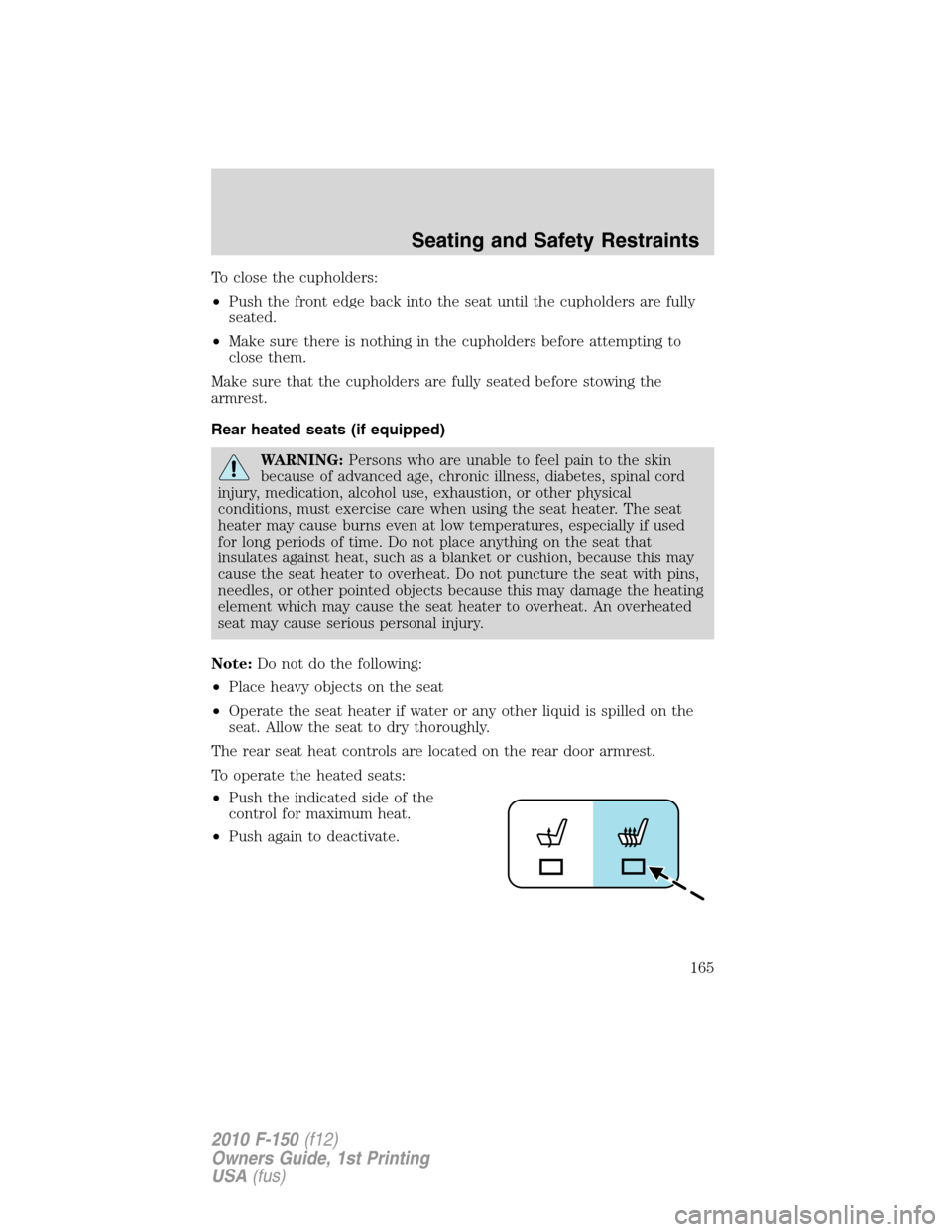
To close the cupholders:
•Push the front edge back into the seat until the cupholders are fully
seated.
•Make sure there is nothing in the cupholders before attempting to
close them.
Make sure that the cupholders are fully seated before stowing the
armrest.
Rear heated seats (if equipped)
WARNING:Persons who are unable to feel pain to the skin
because of advanced age, chronic illness, diabetes, spinal cord
injury, medication, alcohol use, exhaustion, or other physical
conditions, must exercise care when using the seat heater. The seat
heater may cause burns even at low temperatures, especially if used
for long periods of time. Do not place anything on the seat that
insulates against heat, such as a blanket or cushion, because this may
cause the seat heater to overheat. Do not puncture the seat with pins,
needles, or other pointed objects because this may damage the heating
element which may cause the seat heater to overheat. An overheated
seat may cause serious personal injury.
Note:Do not do the following:
•Place heavy objects on the seat
•Operate the seat heater if water or any other liquid is spilled on the
seat. Allow the seat to dry thoroughly.
The rear seat heat controls are located on the rear door armrest.
To operate the heated seats:
•Push the indicated side of the
control for maximum heat.
•Push again to deactivate.
Seating and Safety Restraints
165
2010 F-150(f12)
Owners Guide, 1st Printing
USA(fus)
Page 172 of 419
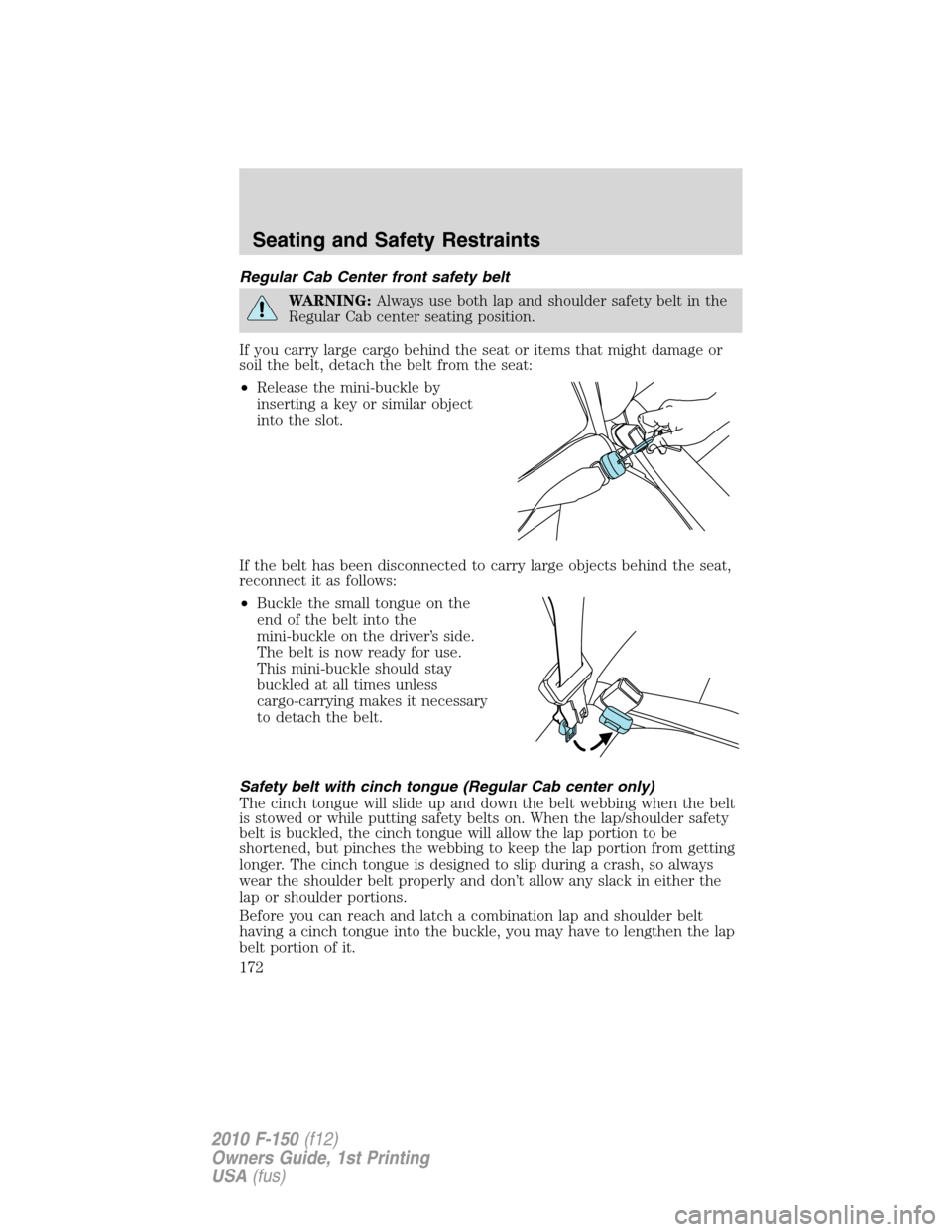
Regular Cab Center front safety belt
WARNING:Always use both lap and shoulder safety belt in the
Regular Cab center seating position.
If you carry large cargo behind the seat or items that might damage or
soil the belt, detach the belt from the seat:
•Release the mini-buckle by
inserting a key or similar object
into the slot.
If the belt has been disconnected to carry large objects behind the seat,
reconnect it as follows:
•Buckle the small tongue on the
end of the belt into the
mini-buckle on the driver’s side.
The belt is now ready for use.
This mini-buckle should stay
buckled at all times unless
cargo-carrying makes it necessary
to detach the belt.
Safety belt with cinch tongue (Regular Cab center only)
The cinch tongue will slide up and down the belt webbing when the belt
is stowed or while putting safety belts on. When the lap/shoulder safety
belt is buckled, the cinch tongue will allow the lap portion to be
shortened, but pinches the webbing to keep the lap portion from getting
longer. The cinch tongue is designed to slip during a crash, so always
wear the shoulder belt properly and don’t allow any slack in either the
lap or shoulder portions.
Before you can reach and latch a combination lap and shoulder belt
having a cinch tongue into the buckle, you may have to lengthen the lap
belt portion of it.
Seating and Safety Restraints
172
2010 F-150(f12)
Owners Guide, 1st Printing
USA(fus)
Page 175 of 419
Shorten and fasten the belt when
not in use.
For long term storage, the lap belt can be placed into a pocket found on
the inside lid of the storage compartment. To store the lap belt, do the
following:
1. Open the storage compartment
lid.
2. Place the lap belt into the pocket
found on the inside lid of the
storage compartment.
3. Fold the center buckle into the
storage compartment.
4. Close the lid.
Before a passenger sits in the front center seat, make sure the lap belt
and buckle are both placed in their in-use position, and no longer
stowed. Always fasten your seat belt when riding in the front center seat.
Seating and Safety Restraints
175
2010 F-150(f12)
Owners Guide, 1st Printing
USA(fus)
Page 181 of 419
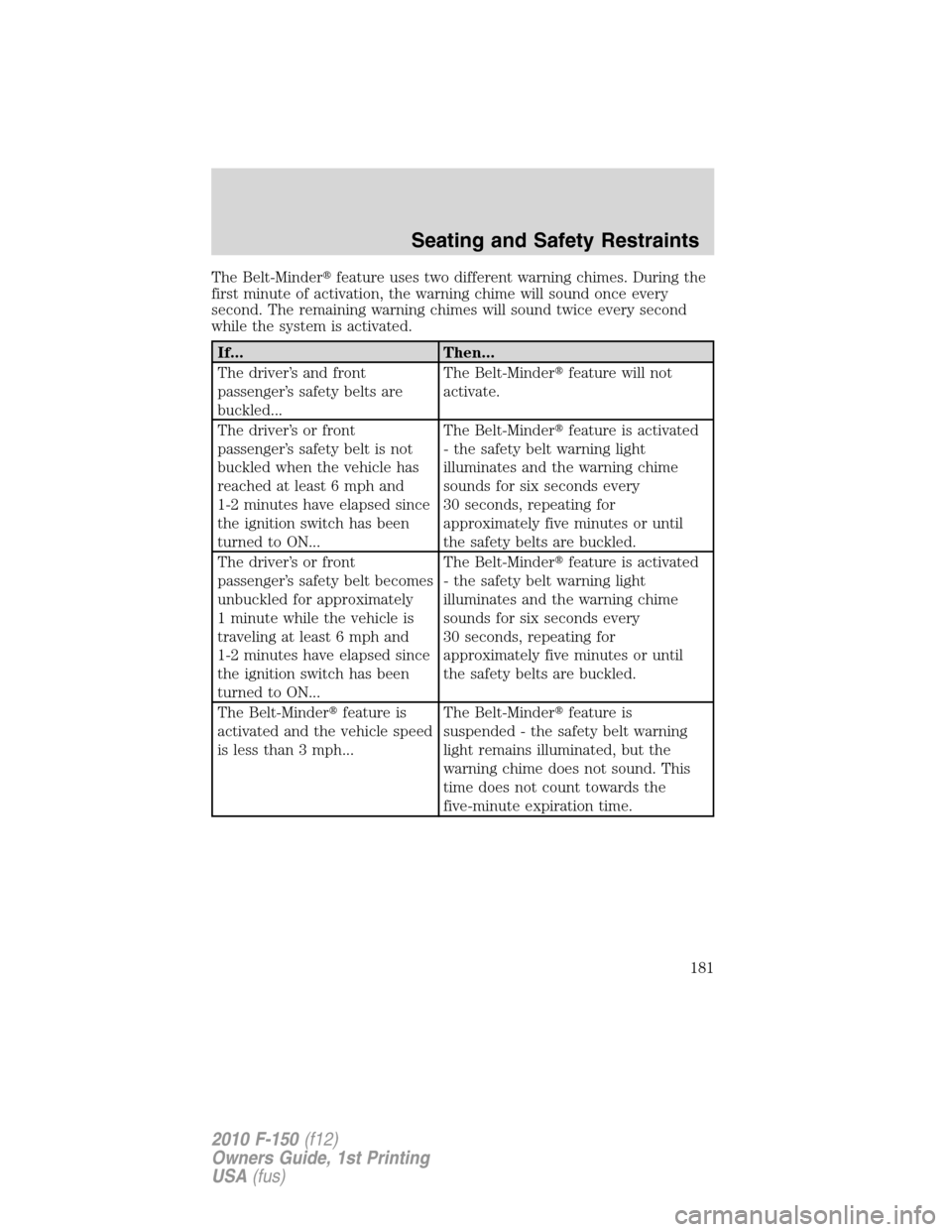
The Belt-Minder�feature uses two different warning chimes. During the
first minute of activation, the warning chime will sound once every
second. The remaining warning chimes will sound twice every second
while the system is activated.
If... Then...
The driver’s and front
passenger’s safety belts are
buckled...The Belt-Minder�feature will not
activate.
The driver’s or front
passenger’s safety belt is not
buckled when the vehicle has
reached at least 6 mph and
1-2 minutes have elapsed since
the ignition switch has been
turned to ON...The Belt-Minder�feature is activated
- the safety belt warning light
illuminates and the warning chime
sounds for six seconds every
30 seconds, repeating for
approximately five minutes or until
the safety belts are buckled.
The driver’s or front
passenger’s safety belt becomes
unbuckled for approximately
1 minute while the vehicle is
traveling at least 6 mph and
1-2 minutes have elapsed since
the ignition switch has been
turned to ON...The Belt-Minder�feature is activated
- the safety belt warning light
illuminates and the warning chime
sounds for six seconds every
30 seconds, repeating for
approximately five minutes or until
the safety belts are buckled.
The Belt-Minder�feature is
activated and the vehicle speed
is less than 3 mph...The Belt-Minder�feature is
suspended - the safety belt warning
light remains illuminated, but the
warning chime does not sound. This
time does not count towards the
five-minute expiration time.
Seating and Safety Restraints
181
2010 F-150(f12)
Owners Guide, 1st Printing
USA(fus)
Page 187 of 419
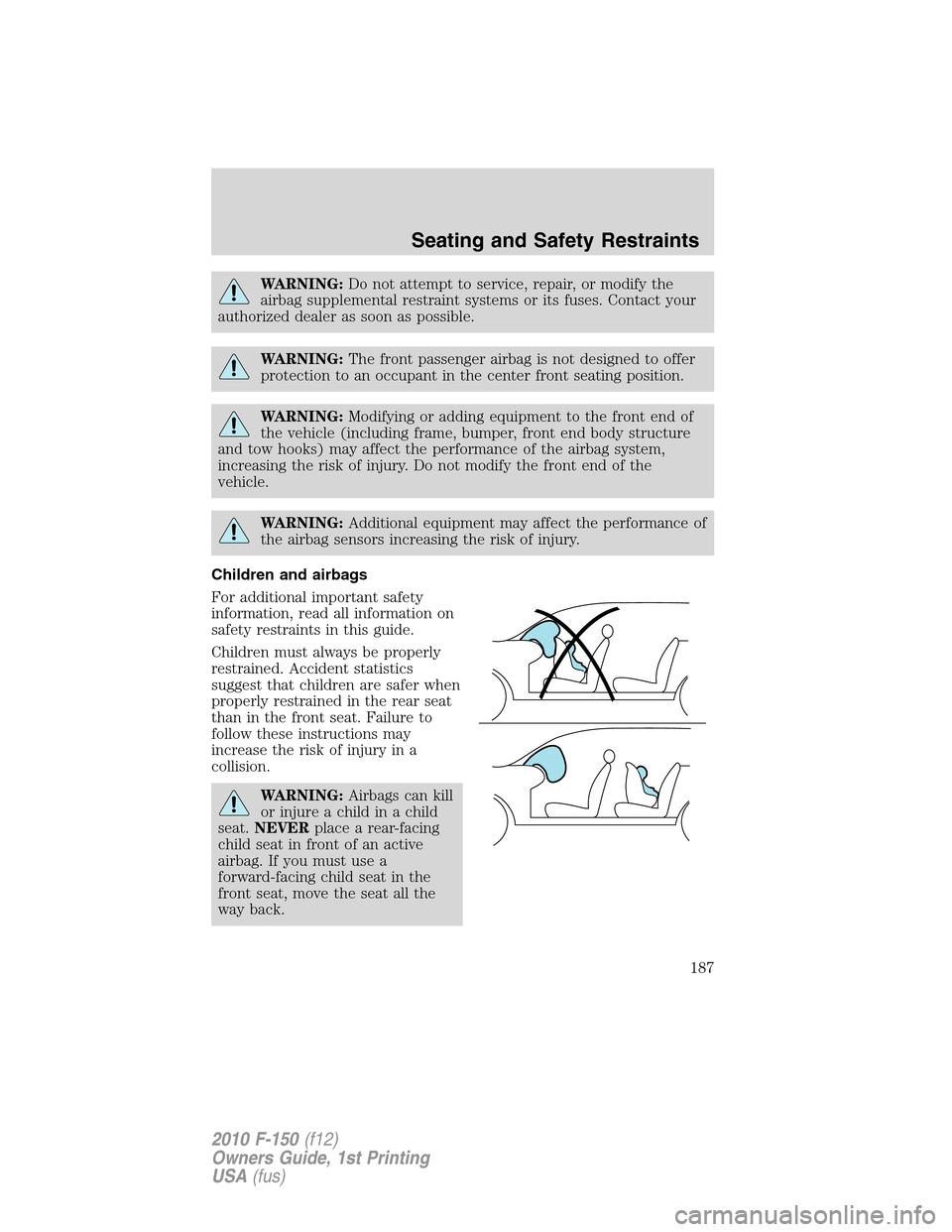
WARNING:Do not attempt to service, repair, or modify the
airbag supplemental restraint systems or its fuses. Contact your
authorized dealer as soon as possible.
WARNING:The front passenger airbag is not designed to offer
protection to an occupant in the center front seating position.
WARNING:Modifying or adding equipment to the front end of
the vehicle (including frame, bumper, front end body structure
and tow hooks) may affect the performance of the airbag system,
increasing the risk of injury. Do not modify the front end of the
vehicle.
WARNING:Additional equipment may affect the performance of
the airbag sensors increasing the risk of injury.
Children and airbags
For additional important safety
information, read all information on
safety restraints in this guide.
Children must always be properly
restrained. Accident statistics
suggest that children are safer when
properly restrained in the rear seat
than in the front seat. Failure to
follow these instructions may
increase the risk of injury in a
collision.
WARNING:Airbags can kill
or injure a child in a child
seat.NEVERplace a rear-facing
child seat in front of an active
airbag. If you must use a
forward-facing child seat in the
front seat, move the seat all the
way back.
Seating and Safety Restraints
187
2010 F-150(f12)
Owners Guide, 1st Printing
USA(fus)
Page 203 of 419
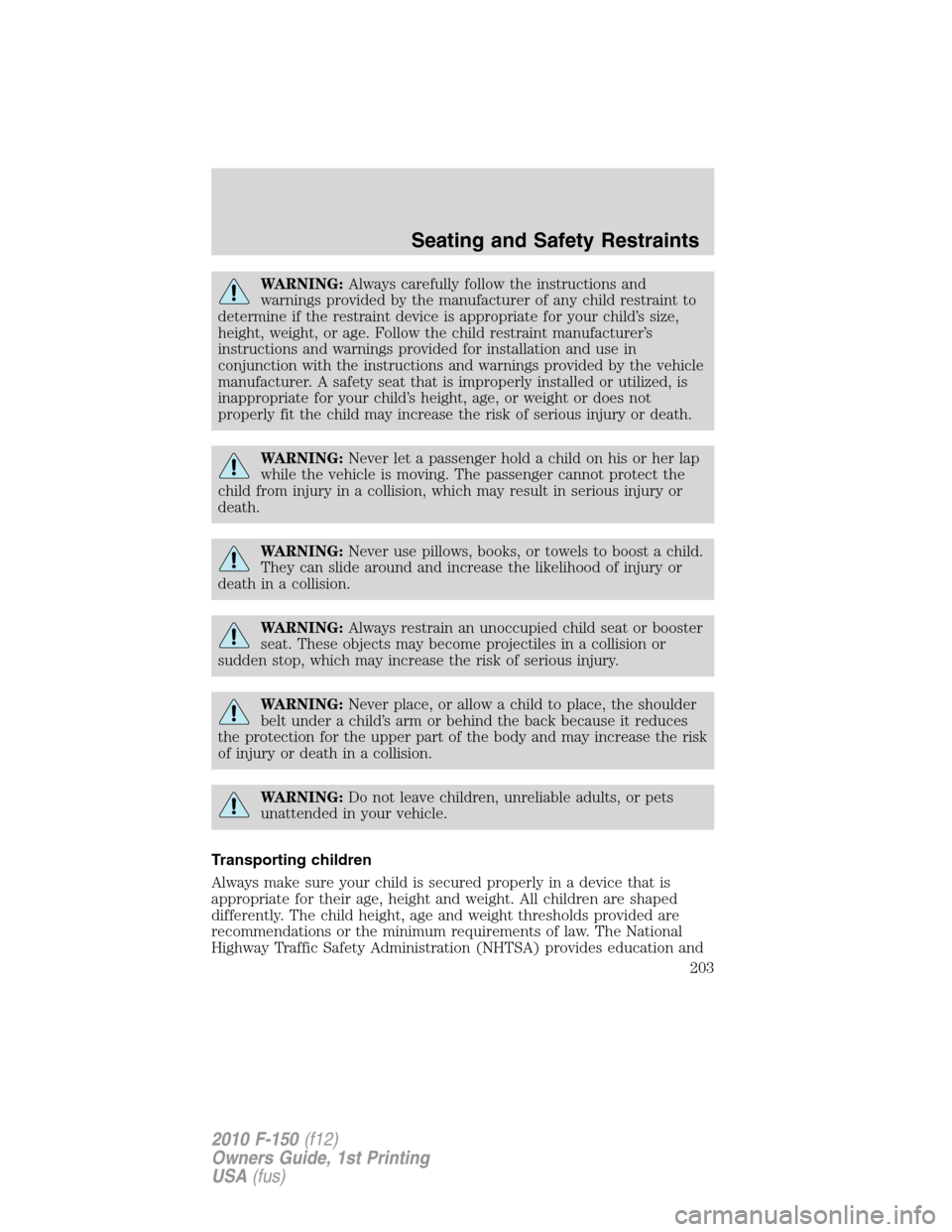
WARNING:Always carefully follow the instructions and
warnings provided by the manufacturer of any child restraint to
determine if the restraint device is appropriate for your child’s size,
height, weight, or age. Follow the child restraint manufacturer’s
instructions and warnings provided for installation and use in
conjunction with the instructions and warnings provided by the vehicle
manufacturer. A safety seat that is improperly installed or utilized, is
inappropriate for your child’s height, age, or weight or does not
properly fit the child may increase the risk of serious injury or death.
WARNING:Never let a passenger hold a child on his or her lap
while the vehicle is moving. The passenger cannot protect the
child from injury in a collision, which may result in serious injury or
death.
WARNING:Never use pillows, books, or towels to boost a child.
They can slide around and increase the likelihood of injury or
death in a collision.
WARNING:Always restrain an unoccupied child seat or booster
seat. These objects may become projectiles in a collision or
sudden stop, which may increase the risk of serious injury.
WARNING:Never place, or allow a child to place, the shoulder
belt under a child’s arm or behind the back because it reduces
the protection for the upper part of the body and may increase the risk
of injury or death in a collision.
WARNING:Do not leave children, unreliable adults, or pets
unattended in your vehicle.
Transporting children
Always make sure your child is secured properly in a device that is
appropriate for their age, height and weight. All children are shaped
differently. The child height, age and weight thresholds provided are
recommendations or the minimum requirements of law. The National
Highway Traffic Safety Administration (NHTSA) provides education and
Seating and Safety Restraints
203
2010 F-150(f12)
Owners Guide, 1st Printing
USA(fus)
Page 208 of 419

8. Remove remaining slack from the
belt. Force the seat down with extra
weight, e.g., by pressing down or
kneeling on the child restraint while
pulling up on the shoulder belt in
order to force slack from the belt.
This is necessary to remove the
remaining slack that will exist once
the additional weight of the child is
added to the child restraint. It also
helps to achieve the proper
snugness of the child seat to the
vehicle. Sometimes, a slight lean
towards the buckle will additionally
help to remove remaining slack from the belt.
9. Attach the tether strap (if the child seat is equipped). Refer to
Attaching child safety seats with tether strapslater in this chapter.
10. Before placing the child in the
seat, forcibly move the seat forward
and back to make sure the seat is
securely held in place. To check
this, grab the seat at the belt path
and attempt to move it side to side
and forward and back. There should
be no more than one inch (2.5 cm)
of movement for proper installation.
11. Ford recommends checking with a NHTSA Certified Child Passenger
Safety Technician (CPST) to make certain the child restraint is properly
installed.
Installing child safety seats in cinch tongue combination lap and
shoulder belt seating position (Front center seating position only)
If you are using a regular cab center seat, seeCenter front safety belt
(Regular Cab center seating position only)underCombination lap
and shoulder beltsearlier in this chapter for instructions on attaching
the mini-buckle.
The belt webbing below the tongue is the lap portion of the combination
lap/shoulder belt, and the belt webbing above the tongue is the shoulder
belt portion of the combination lap/shoulder belt.
Seating and Safety Restraints
208
2010 F-150(f12)
Owners Guide, 1st Printing
USA(fus)